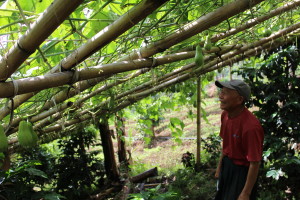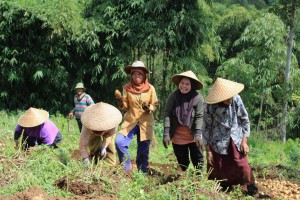One of the more time consuming tasks of doing fieldwork of any kind, is getting permission for your research. Taking months to acquire my research permit and visa to stay in Indonesia for this year, I needed the approval of various authorities, both internationally and locally. I applied for my Visa and research permit in the United Kingdom, collected my visa from the USA, collected my research permit in Jakarta, followed by Tasik immigration to collect my KITAS and finally, get all this approved by the Kepala Desa (village chief) of Cipaganti, Indonesia. Collectively, this took maybe a total of 7 months – an exhausting process, but all the more rewarding to finally have everything in hand. And last but certainly not least, there is the permission required from local land owners, where you want to conduct research.
More and more every year, primate species are overlapping with human populated areas. This varies from cities to rural area and in our case, agricultural land. When you are doing research in a park you apply for that as a part of your visa, but when you want to work on local owned land, you need to get permission from each property owner that your study group ranges across. Fortunately, our conservation education and outreach programmes here have aided in this tremendously. Arriving to a village that has already learned to love both the Javan slow lorises and our project, permission had been given by farmers upon establishing our field site from the start, and we can freely follow lorises each night, wherever they decide to meander.

The more difficult aspect of this has been getting permission for my ecology research. A large portion of the trees here have been planted by the farmers themselves. A common method used for long-term vegetation plots is to mark individual trees, so you can monitor any changes over time. Some methods include using small tin nails and tree tags, but often, farmers do not like this. They believe it will hurt their trees and so, we needed to find a compromise. Brain storming with the entire team – this is quite possibly my favourite thing about field research – new or modified methods, where creativity makes a guest appearance in science! As nerdy as this may sound, it’s ridiculously exciting to find solutions to these kind of obstacles, and more so if they are methods that can help someone else in similar scenarios. Discussing different methods we researched, the trackers thought up a modification using wooden stakes to mark the outer perimeter of each vegetation plot, using rain-proof paint and then biodegradable flagging tape that we would replace whenever necessary. Using randomly selected plots, this took time to find out who owned what land, but once we talked with each land owner, they were more than happy to allow us to use this alternative method. This took a total of 4 months to solidify, but would be worth it in the long-haul. On top of now being able to monitor the habitat and vegetation over the coming years, every time we hike up during the day for this, the farmers greet us with smiles and the friendliest of ‘hallos!’. It’s important to work and speak with people in your area about what you are studying, because at the end of the day it’s their support you need more than anything to protect any species. It’s not just lorises we are studying, but the coexistence of lorises and humans in the same habitat, how they cope, and how they can survive.

- Kathleen Reinhardt, PhD Researcher
